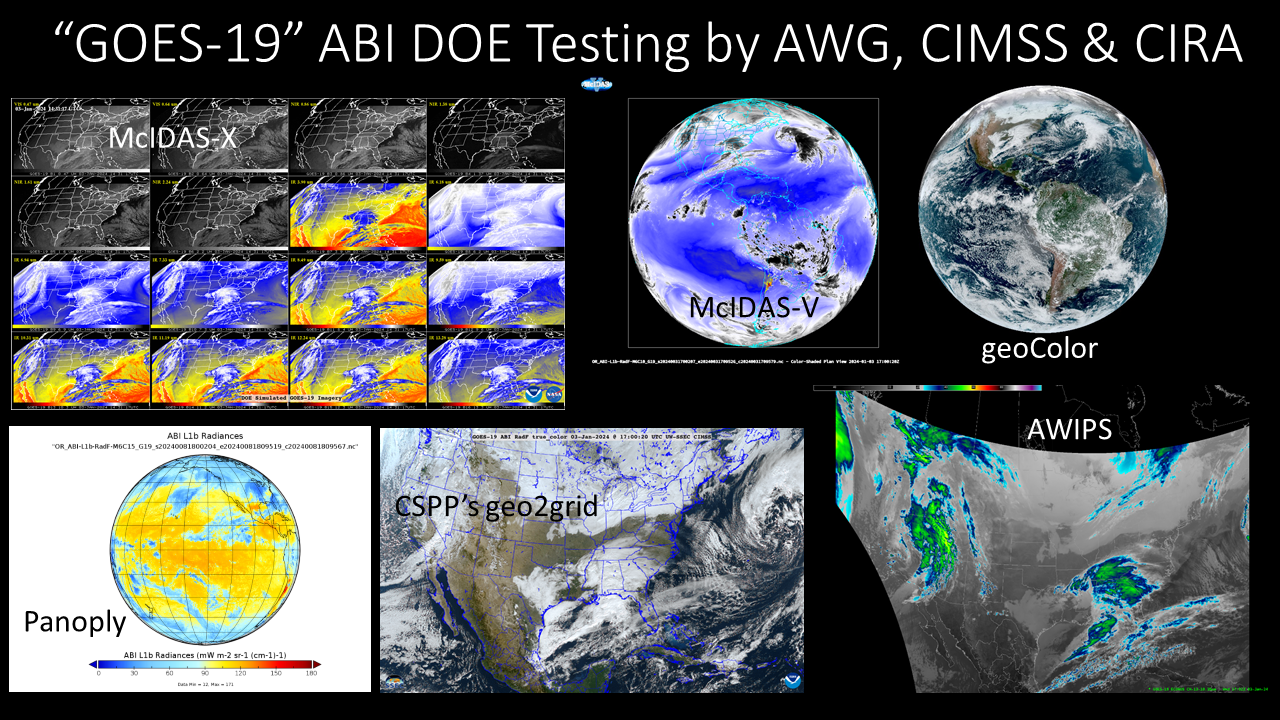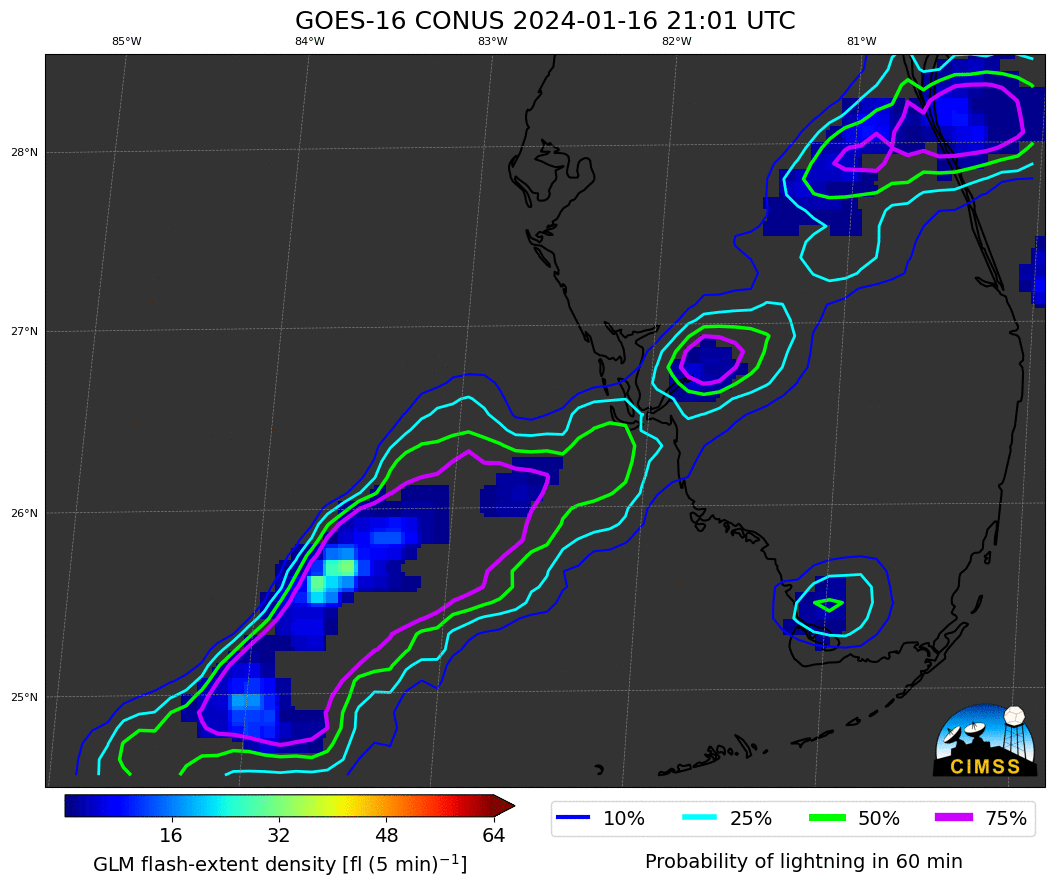
[ Archive ]

 |
CIMSS-NOAA Weekly Report [ Archive ] |
 |
CIMSS-NOAA WEEKLY HIGHLIGHTS FOR THE WEEK ENDING JANUARY 19, 2024
DATA, INFORMATION, AND USE-INSPIRED SCIENCE:
CIMSS and STAR get ready for GOES-U Post Launch Test: The GOES-R Algorithm Working Group (AWG) Imagery Team at the Cooperative Institute for Meteorological Satellite Studies (CIMSS), which includes colocated STAR scientists, checked out recent "GOES-19" Advanced Baseline Imager (ABI) simulated data produced during a Data Operations Exercise (DOE). The files are generated from operational GOES-East and GOES-West ABI data that are run through the test system to produce L1b and L2 files. To make sure scientists are prepared for the upcoming GOES-U (which will become GOES-19 upon successfully reaching geostationary orbit) post launch test, these data files were read into multiple visualization and analysis tools that are used at the University of Wisconsin's Space Science & Engineering Center (SSEC) and CIMSS, the Cooperative Institute for Research in the Atmosphere (CIRA) at Colorado State University, the National Weather Service (NWS), and NASA. Tools tested included AWIPS (NWS), McIDAS-X (SSEC), McIDAS-V (SSEC), Geo2Grid (SSEC), Slider (CIRA), and Panoply (NASA), and all are prepared to handle ABI data from the next in the GOES-R series. (M. Gunshor, CIMSS, matg@ssec.wisc.edu; T. Schmit, E/RA2, 608-263-0291, tim.j.schmit@noaa.gov; C. Seaman, CIRA, Curtis.Seaman@colostate.edu; B. Line, SMCD/APDB, bill.line@noaa.gov)
 (Click image to enlarge)
(Click image to enlarge)
Figure: Various simulated GOES-19 ABI images from a January 2024 Data Operations Exercise (DOE) using the most popular visualization software packages, including Advanced Weather Interactive Processing System (AWIPS) which is the primary visualization tool of the National Weather Service.
FUTURE OUTLOOK:
AWARDS AND RECOGNITION:
TRAVEL AND MEETINGS:
JPSS Cryosphere Highlights Presentation to LEO Director: STAR leadership and the NOAA/NESDIS Low Earth Orbit (LEO) Program proposed having occasional meetings to present highlights of STAR's JPSS work to Tim Walsh, Director of the Office of Low Earth Orbit Observations. The first meeting was 19 January 2023. Given the broad spectrum of JPSS work in STAR, it was decided that the first meeting would focus on recent activities in the areas of sensors and imagery, atmosphere, ocean, cryosphere, and land. Yinghui Liu (STAR at CIMSS) showed highlights of JPSS cryosphere research, briefly covering new products, validation, and climatological applications of VIIRS and AMSR2 cryosphere products. (Y. Liu, E/RA2, 608-890-1893, yinghui.liu@noaa.gov; J. Key, E/RA2, 608-263-2605, jeff.key@noaa.gov)
TRAINING AND EDUCATION:
VISIT Training on TROWALs: Scott Lindstrom from the Cooperative Institute for Meteorological Satellite Studies (CIMSS) gave a live training on Troughs of Warm Air Aloft (TROWALs) as part of the Virtual Institute for Satellite Integration Training (VISIT). The training was presented to the new Science and Operations Officer (SOO) at the NWS Ocean Prediction Center (OPC) and concluded with a general discussion on training for the Ocean and tools/training that are already available. (S. Lindstrom, CIMSS, 608 263 4425)
MEDIA INTERACTIONS AND REQUESTS:
SOCIAL MEDIA AND BLOG Posts:
SSEC and CIMSS Scientists in the news: Scientists at the University of Wisconsin-Madison (UW) Space Science and Engineering Center (SSEC) and the Cooperative Institute for Meteorological Satellite Studies (CIMSS) provide expert interviews, imagery and case studies to promote science and satellite imagery. This week: 1) CIMSS Satellite Blog contributors Scott Bachmeier and Scott Lindstrom published the following case studies: "Single-banded snow squall along the length of Lake Michigan" (January 19); "Tehuano wind event" (January 09); "LightningCast probability with a High Plains blizzard" (January 17); "Coming soon: CSPP Geo software to create LightningCast probability fields" (January 17); "Standing waves downwind of the Hawai’ian Islands" (January 16); "Arctic air leads to frozen lakes" (January 15); "New volcanic fissure eruption near Grindavik, Iceland" (January 14); "Satellite signatures of a SpaceX Falcon 9 rocket launch from California" (January 14); “River effect” cloud bands and blowing snow in South Dakota" (January 13); "LightningCast lead time with a winter storm affecting the Midwest and Great Lakes" (January 12); "Using NOAA-20 NUCAPS profiles to assess model field accuracy" (January 12). Read more at the CIMSS Satellite Blog: https://cimss.ssec.wisc.edu/satellite-blog/. 2) SSEC Director Brad Pierce conducted an interview with Channel 3000 News about cold temperatures and air quality: "Breathing in cold air increases health risks" https://bityl.co/Nfud. (S. Lindstrom, CIMSS, 608-263-4425; S. Bachmeier, CIMSS; R.B. Pierce, SSEC, 608-890-1892; E. Verbeten, SSEC, 608-263-4206)
 (Click image to enlarge)
(Click image to enlarge)
Figure: Scientists/Programmers at CIMSS are working on a CSPP Geo package that will create LightningCast probability fields, both current and historical. The software has the ability to subsect data, so full-disk (or full-CONUS for GOES-16 or full-PACUS for GOES-18) imagery need not be created.
PUBLICATIONS:
OTHER:
| Archived Weeklies Page | Submit a report item |